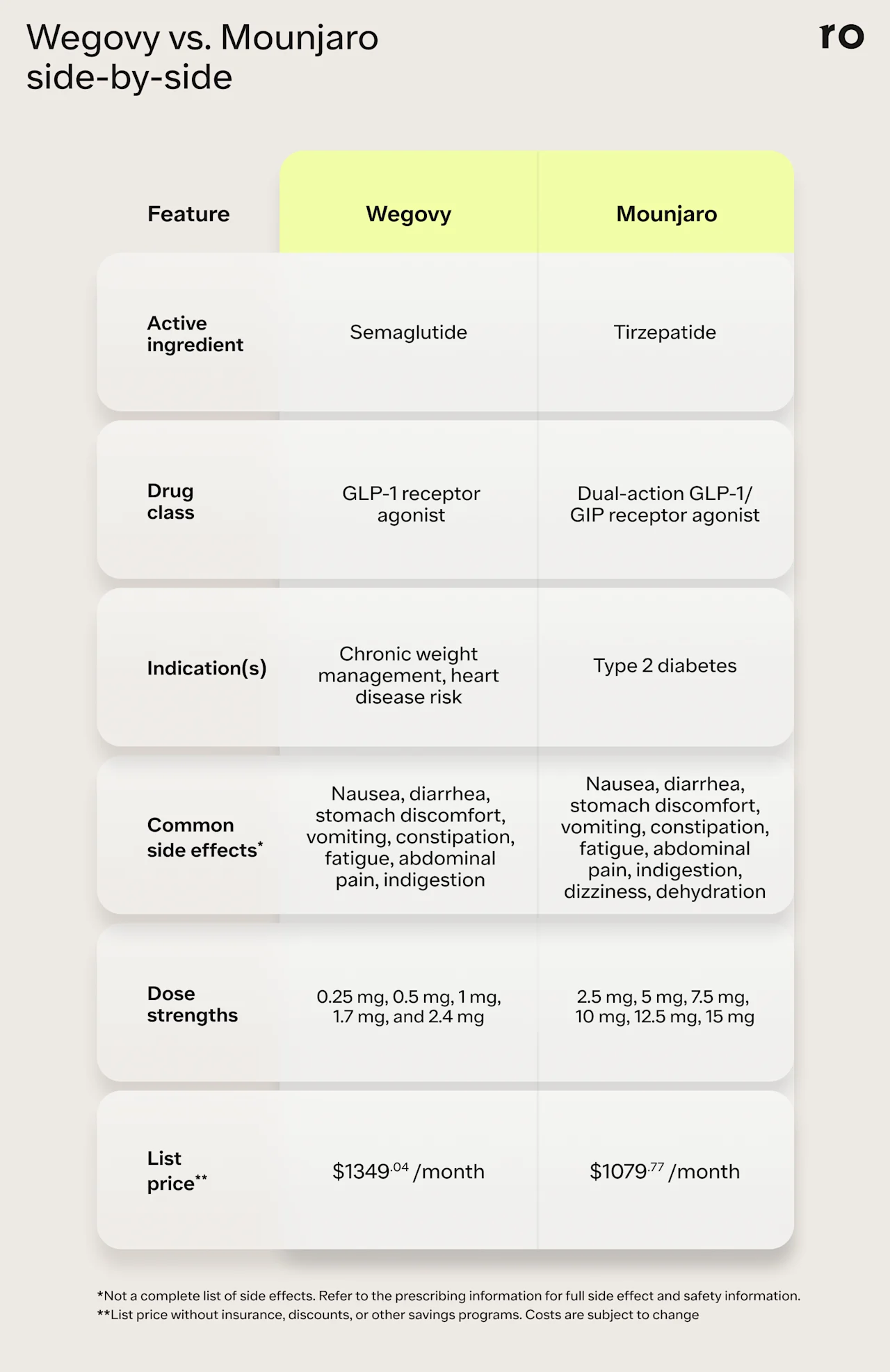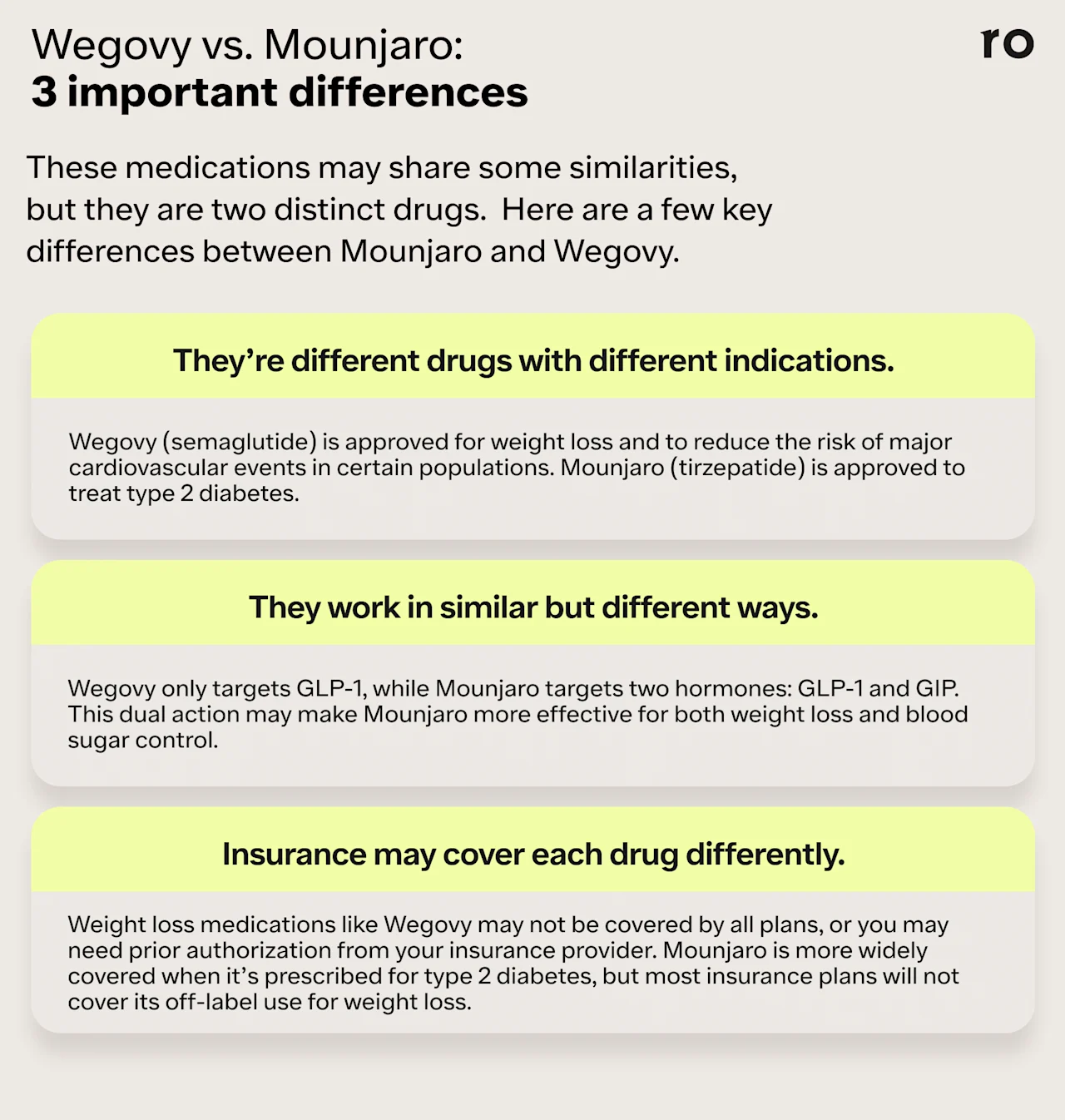Key takeaways
Wegovy (semaglutide) and Mounjaro (tirzepatide) are similar but different GLP-1 medications that can help manage weight and control blood sugar.
Wegovy is FDA-approved for weight loss. Mounjaro is only approved to treat type 2 diabetes, though some doctors may prescribe it off-label for weight loss.
Some research suggests that tirzepatide (the active ingredient in Mounjaro) is more effective for weight loss and blood sugar management.
Here's what we'll cover
Here's what we'll cover
Key takeaways
Wegovy (semaglutide) and Mounjaro (tirzepatide) are similar but different GLP-1 medications that can help manage weight and control blood sugar.
Wegovy is FDA-approved for weight loss. Mounjaro is only approved to treat type 2 diabetes, though some doctors may prescribe it off-label for weight loss.
Some research suggests that tirzepatide (the active ingredient in Mounjaro) is more effective for weight loss and blood sugar management.
Navigating weight loss treatment can be overwhelming, especially with many available options. If you’ve been researching weight loss medications you’ve probably come across names like Wegovy (semaglutide) and Mounjaro (tirzepatide).
While these medications share some similarities and can both be effective tools for weight loss, they are two distinct drugs with some key differences. Wegovy is approved for weight loss, while Mounjaro isn’t, though some providers may still prescribe it off-label for that purpose.
How do these drugs compare for weight loss, and which treatment is better for you? The answer depends on your unique health goals.
“Different people have different needs and responses to various therapies,” says Marlena Klein, DO, a board-certified physician in Internal Medicine. “Effective obesity treatment often requires a comprehensive and individualized approach customized to each person's needs and circumstances.”
That’s why making an informed decision is crucial. Read on for an in-depth comparison of Wegovy vs. Mounjaro—including side effects, costs, and effectiveness—to help you decide which is best for your needs.
Wegovy Important Safety Information: Read more about serious warnings and safety info.
Mounjaro Important Safety Information: Read more about serious warnings and safety info.
Wegovy vs. Mounjaro: what’s the difference?
Wegovy and Mounjaro are both injectable medications called glucagon-like peptide-1 receptor agonists, or GLP-1s. While they are similar medications, they do have some key differences, including their active ingredients, approved indications, costs, and slight differences in how they work.
Before we dive into more detail, let’s take a quick look at some key facts about each drug.

GLP-1 Important Safety Information: Read more about serious warnings and safety info.
What is Wegovy?
Drug class: Wegovy is a glucagon-like peptide-1 (GLP-1) receptor agonist. The active ingredient in Wegovy is semaglutide.
Indication(s): Wegovy is a GLP-1 medication approved by the US Food and Drug Administration (FDA)for weight management in adults with obesity or adults with overweight who also have a related condition like high blood pressure, type 2 diabetes, or high cholesterol. It’s also approved for children 12 and older with obesity. It’s also approved to reduce the risk of major cardiovascular events (like heart attack and stroke) in adults with heart disease who have obesity or overweight.
Form and frequency: Wegovy comes in a prefilled, single-dose pen that you inject once weekly. It’s taken on the same day each week.
Dosing: Wegovy comes in five dose strengths: 0.25 mg, 0.5 mg, 1 mg, 1.7 mg, and 2.4 mg. The dosing schedule for Wegovy typically starts at the lowest dose (0.25 mg) Your healthcare provider may then gradually increase your dose every four weeks, depending on how well you tolerate the medication.
Mechanism of action: Wegovy works by mimicking GLP-1, a type of hormone made in the intestines. GLP-1 may help promote weight loss by suppressing appetite and slowing down parts of digestion to help you feel full longer.
What is Mounjaro?
Drug class: Mounjaro is a dual-action glucagon-like peptide-1 (GLP-1)/glucose-dependent insulinotropic polypeptide (GIP) receptor agonist. It contains the active ingredient tirzepatide.
Indication(s): Mounjaro is FDA-approved for type 2 diabetes.
Form and frequency: Mounjaro comes in a single-dose pen that you inject once per week, on the same day each week.
Dosing: Mounjaro comes in six dose strengths: 2.5 mg, 5 mg, 7.5 mg, 10 mg, 12.5 mg, and 15 mg. Similar to other GLP-1 medications, the dosing schedule for Mounjaro usually starts at the lowest dose and then may be gradually increased every four weeks until you reach your maintenance dose. Your healthcare provider will monitor your progress and side effects to determine the correct maintenance dose.
Mechanism of action: Mounjaro uses a dual-action mechanism to target both GLP-1 and GIP receptors in the body. GLP-1 and GIP are both naturally occurring gut hormones that can impact blood sugar levels and promote weight loss.
Can I take Mounjaro for weight loss?
Some healthcare providers may prescribe Mounjaro off-label for weight management, but Mounjaro is currently only approved for type 2 diabetes. In 2023, the FDA approved tirzepatide for weight loss under the brand name Zepbound.
Zepbound Important Safety Information: Read more about serious warnings and safety info.
How do Wegovy and Mounjaro work?
Wegovy and Mounjaro work in similar but slightly different ways. Both medications mimic a naturally occurring gut hormone called GLP-1; however, because Mounjaro is a dual-action medication, it mimics GLP-1 as well as another hormone called GIP.
GLP-1 and GIP are both incretin hormones that are secreted by the gut after eating. They serve a variety of functions that can help regulate blood glucose (sugar) and promote weight loss, including:
Improving insulin sensitivity. GLP-1 stimulates the release of insulin in the pancreas after eating. Insulin is a hormone that helps transport sugar in the bloodstream into one’s cells where it is turned into energy. By triggering insulin production, medications like Wegovy and Mounjaro can help regulate blood sugar levels.
Reducing glucagon secretion. Glucagon is another hormone produced in the pancreas that prevents blood sugar from dropping too low. It triggers the liver to release glucose and raise blood sugar levels, which can contribute to high blood sugar in people with type 2 diabetes.
Suppressing appetite. Wegovy and Mounjaro bind to GLP-1 and GIP receptors in the brain to reduce hunger cues. People taking these medications also report less “food noise,” a colloquial term that describes persistent and intrusive thoughts about food.
Slowing gastric emptying. GLP-1 medications also slow down how quickly food moves from the stomach to the small intestine. This can help you to feel full faster, and can also help you feel more satisfied in between meals.
Mounjaro’s dual-action mechanism may enhance these effects, which could potentially lead to better blood sugar control and more significant weight loss results.
Mounjaro vs. Wegovy: weight loss
Semaglutide and tirzepatide both demonstrated positive weight loss results in separate clinical trials.
Even though Mounjaro is not specifically indicated for weight management, some research suggests it may promote more significant weight loss than Wegovy.
In a 68-week study with 1,961 participants, those who took semaglutide at a dose of 2.4 mg per week lost an average of 14.9% of their body weight, compared to 2.4% in the placebo group. In addition to weight loss, participants in the semaglutide group also saw improvements in waist size, blood pressure, and overall physical fitness.
In a 2022 study, participants who took a weekly dose of 15 mg of tirzepatide lost an average of 20.9% of their body weight over 72 weeks, compared to just 3.1% in the placebo group.
Lastly, one cohort study compared the impact of semaglutide vs. tirzepatide in 18,386 adults with obesity. While both medications helped participants lose 5% or more of their body weight, the study noted that those taking tirzepatide lost more weight overall. At 12 months, patients taking tirzepatide lost 15.3% of body weight compared to 8.3% with semaglutide.
These results suggest that medications containing tirzepatide (such as Mounjaro or Zepbound) outperform semaglutide for weight loss, but more research is needed to confirm this.
“It appears that the practical implication of targeting both GLP-1 and GIP is that tirzepatide exerts, on average, a greater effect on weight,” says registered pharmacist Ted Kyle, RPh, MBA. “One might expect that people could see a better effect on other outcomes related to metabolic health with tirzepatide.”
The amount of weight you can lose on either drug may vary. Every weight loss journey is unique—factors like overall health, starting weight, genetics, and how your body responds to medication can affect individual results.
Wegovy and Mounjaro are designed for long-term use—each of these clinical trials lasted a year or longer. The duration of use depends on your health goals, progress, and how well you tolerate the medication. Some people may stay on these medications for months or years (and sometimes, indefinitely) to maintain weight loss results or blood sugar control.
Lifestyle tips to optimize treatment with Wegovy and Mounjaro
For optimal results with either medication, experts recommend eating a balanced diet, getting regular exercise, and prioritizing other healthy habits like good sleep, hydration, and stress management.
“Just because we have more effective options now to aid with weight loss does not mean we should discredit the lifestyle changes that are necessary,” Dr. Klein says. “I typically recommend that patients work with their providers and health coaches to make sustainable changes before turning to medication.”
Simple adjustments can help you build habits supporting weight management and overall wellbeing while taking a GLP-1.
Here are some tips to help you get started:
Eat balanced meals. Fill your plate with nutrient-rich foods and reduce processed items and added sugars.
Move your body. Try to get about 150 minutes of exercise each week. Find workouts or movements that you enjoy—and can stick to. Daily walks are an easy way to stay active, while cardio and strength training can help build muscle and boost metabolism.
Drink up. Stay hydrated by sipping water or other unsweetened beverages throughout the day. This can help reduce dehydration from potential GI side effects and help increase feelings of satiety between meals.
Prioritize sleep. Aim for 7-9 hours of sleep each night to help your body repair and recover. Research suggests that regularly getting quality sleep can also help regulate hunger and fullness hormones.
Dr. Klein says the above tips may also help mitigate weight gain if you stop GLP-1 treatment.
“Inevitably, [patients] may have a minor weight regain because we are removing an appetite suppressant,” she says. “The goal is that it does not return to the original set [weight] point.”
The most important thing is to find habits that fit with your lifestyle that you can stick to long-term.
Wegovy vs. Mounjaro: side effects and risks
Both medications can create similar side effects. The most common side effects include gastrointestinal issues like nausea, diarrhea, and vomiting.
“The frequency and intensity of the side effects vary from patient to patient,” says Dr. Klein. “I do tell patients to expect a mild level of nausea the day after they inject the medication.”
Some common side effects of Wegovy include:
Nausea
Diarrhea
Vomiting
Constipation
Dizziness
Heartburn
Headache
Gas
Bloating
Stomach pain
Upset stomach
Mounjaro side effects include:
Nausea
Diarrhea
Vomiting
Indigestion
Constipation
Stomach pain
Decreased appetite
These side effects tend to be mild and manageable and typically go away after you’ve been on the medication for a while.
Dr. Klein says you should talk to your healthcare provider if symptoms become severe or impact your quality of life. They can help you find ways to manage common side effects or may recommend a different medication.
“Providers can help with patient’s side effects by encouraging stool softeners if constipated, antacid medications if reflux occurs, or fiber tablets if diarrhea occurs,” she adds.
Warnings and precautions for Wegovy and Mounjaro
Both Wegovy and Mounjaro can come with rare but serious side effects, including:
Pancreatitis (inflammation of the pancreas)
Allergic reactions, including anaphylaxis
Acute kidney injury
Acute gallbladder disease (gallstones or gallbladder inflammation)
Vision changes
Hypoglycemia (low blood sugar)
Both Wegovy and Mounjaro carry a black box warning indicating a potential increased risk for thyroid cancer. Research on lab animals (but not in humans) showed an increase in cancerous and non-cancerous thyroid tumors. As a result, people with a family or personal history of thyroid cancer or tumors may not be good candidates for GLP-1 treatment.
It’s important to monitor any symptoms or side effects when taking Wegovy or Mounjaro. If you experience severe symptoms, stop taking the medication and contact your provider.
Wegovy vs. Mounjaro cost and accessibility
The cost of GLP-1 medications can vary depending on your location, insurance coverage, and eligibility for assistance programs.
Getting insurance coverage for weight loss medications like Wegovy and Mounjaro can be challenging. For example, some plans may not cover weight loss medications like Wegovy, or if they do, you may have to get prior authorization from your insurance company first.
More insurance plans cover Mounjaro when it’s prescribed for type 2 diabetes but may not cover it or other off-label diabetes medications for weight loss.
Check with your insurance provider to see if your preferred medication is covered. If so, you may also be eligible for manufacturer savings cards or other patient assistance programs that can help offset out-of-pocket costs.
Wegovy cost
The current list price for Wegovy before insurance or other discounts is $1,349.02 per month. If you have a commercial insurance plan that covers Wegovy and you meet certain eligibility requirements, you may pay as little as $0 per month through the WeGoTogether Savings Program.
Novo Nordisk (the maker of Wegovy) also has a program where people who are uninsured or whose commercial insurance doesn’t cover Wegovy can access the medication for $650 per month. For both programs, your monthly out-of-pocket expenses (such as copays or coinsurance) must be more than $849 to be eligible for savings.
Mounjaro cost
The list price for Mounjaro is $1,070.77 per month before insurance, savings programs, or discounts. If you’re eligible for a Mounjaro Savings Card, you may pay as little as $25 for a one- or three-month supply of medication.
To be eligible for the Mounjaro Savings Card, you have to:
Have been prescribed Mounjaro for an FDA-approved use (type 2 diabetes)
Be enrolled in a commercial insurance plan (state, federal, and government-funded programs—including Medicare and Medicaid—do not qualify for the savings card)
Be a resident of the US or Puerto Rico
Be 18 or older
Other ways to save on Wegovy and Mounjaro
Some consumer drug sites like GoodRx and SingleCare may also offer pharmacy-specific coupons for Wegovy or other Mounjaro discounts that can help reduce out-of-pocket costs.
Telehealth options like Ro’s Body membership can also help you work with your insurance for coverage if you qualify. Ro connects you with a licensed healthcare professional to provide personalized support, coaching, and, if appropriate, medication to help support your health and weight loss goals. Get started with a brief questionnaire and free insurance check to see if Ro Body is right for you.
Which is better, Wegovy or Mounjaro?
Both Wegovy and Mounjaro can help with weight management. While these two medications have not been compared directly, available clinical trial data suggest that Mounjaro may be more effective for weight loss and blood sugar control.
However, there are various factors to consider when determining which medication is best for you and your unique needs. This includes things like cost and insurance coverage, your overall health, side effects, and how well the medication fits your lifestyle and goals.
“The weight loss [these medications] produce can make it easier for a person to be more physically active,” Kyle says. “These health habits are very personal, which is why personalized plans are essential.”

Questions to ask your doctor about Wegovy and Mounjaro
The first step to finding the right weight loss injection is to talk to your healthcare provider. They can help evaluate the potential benefits and drawbacks of each medication.
Here are some questions to discuss with your healthcare provider:
Am I eligible for weight loss medication?
Will my insurance cover the medication?
What types of side effects might I experience?
How do the risks compare to the benefits I can expect?
What happens if I stop taking the medication?
How long will I have to take the medication to see or maintain results?
Could this medication affect any of my other prescriptions or health conditions?
Your healthcare provider plays a crucial role in your weight loss journey. They can offer support, adjust your treatment as needed, and monitor your progress to ensure you stay on track.
Bottom line
Wegovy and Mounjaro share some similarities, but they are two distinct medications with important differences.
Wegovy and Mounjaro have different FDA-approved indications. Both medications can be effective for weight loss, but only Wegovy is approved for that purpose. Mounjaro is approved for type 2 diabetes. Healthcare providers may prescribe Mounjaro off-label for weight loss, or they may prescribe Zepbound, a version of tirzepatide that is indicated for weight management.
They work in slightly different ways. Wegovy acts on GLP-1 receptors in the body, while Mounjaro targets both GLP-1 and GIP. This dual-action mechanism may make it more effective for weight loss and blood sugar control.
Research suggests that tirzepatide is better than semaglutide for weight loss. In a clinical trial looking at treatment with the maximum dose of Wegovy (2.4 mg weekly), participants lost over 14% of body weight at 68 weeks. In another trial studying treatment with 15 mg of tirzepatide (the maximum dose of Mounjaro and Zepbound), patients lost just over 20% of their body weight after 72 weeks.
Both medications can cause similar side effects, such as nausea, indigestion, and constipation.
Wegovy and Mounjaro can be expensive. The monthly cost for the drugs ranges between $1,000 and $1,400, depending on factors like insurance, savings programs, and other discounts. Weight loss medications and off-label prescriptions may not be covered by insurance.
Always talk to a knowledgeable healthcare provider before starting a new medication. They can evaluate your health goals, medical history, and other factors to help find the best treatment for your unique needs.
Frequently asked questions (FAQs)
Is Mounjaro better than Wegovy for weight loss?
Mounjaro and Wegovy can both promote weight loss, but Mounjaro may have the edge as it targets both GLP-1 and GIP receptors, while Wegovy focuses solely on GLP-1.
Is Mounjaro better for weight loss than Ozempic?
Mounjaro may offer better weight loss results than Ozempic since it mimics GLP-1 and GIP hormones, while Ozempic only targets GLP-1. This dual action of Mounjaro may help regulate appetite and improve insulin sensitivity more effectively. However, Mounjaro and Ozempic are only FDA-approved to treat type 2 diabetes and are not indicated for weight loss. If you are interested in GLP-1 treatment for weight loss, your healthcare provider might recommend medications such as Zepbound, Wegovy, or Saxenda, which are FDA-approved for weight management.
Ozempic Important Safety Information: Read more about serious warnings and safety info.
Saxenda Important Safety Information: Read more about serious warnings and safety info.
How much weight can you lose in 3 months with Wegovy?
The weight you can lose with Wegovy in three months depends on factors like your starting weight, lifestyle, and how your body responds to the medication. In one study, people taking the maximum dose of Wegovy lost around 15% of their body weight in 68 weeks.
However, results can vary, so it’s essential to consult with your healthcare provider to set realistic weight loss goals tailored to your needs.
Can I switch from Mounjaro to Wegovy?
If you are taking Mounjaro off-label for weight loss, you may want to switch to a medication that’s specifically indicated for weight loss, such as Wegovy or Zepound. However, if you take Mounjaro for type 2 diabetes, your healthcare provider would likely switch you to another diabetes medication, such as Ozempic.
Always talk to your healthcare provider for guidance before changing medications. They’ll help you determine the best course of treatment for your unique health needs and goals.
DISCLAIMER
If you have any medical questions or concerns, please talk to your healthcare provider. The articles on Health Guide are underpinned by peer-reviewed research and information drawn from medical societies and governmental agencies. However, they are not a substitute for professional medical advice, diagnosis, or treatment.
Aronne, L. J., Sattar, N., Horn, D. B., et al. (2024). Continued treatment with tirzepatide for maintenance of weight reduction in adults with obesity: The SURMOUNT-4 randomized clinical trial. JAMA, 331(1), 38–48. doi: 10.1001/jama.2023.24945. Retrieved from https://pmc.ncbi.nlm.nih.gov/articles/PMC10714284/
Canadian Agency for Drugs and Technologies in Health. (2022). Semaglutide (Wegovy): CADTH Reimbursement Review: Therapeutic area: Weight management. Canadian Agency for Drugs and Technologies in Health. Retrieved from https://www.ncbi.nlm.nih.gov/books/NBK601688/
Chavda, V. P., Ajabiya, J., Teli, D., et al. (2022). Tirzepatide, a new era of dual-targeted treatment for diabetes and obesity: A mini-review. Molecules (Basel, Switzerland), 27(13), 4315. doi: 10.3390/molecules27134315. Retrieved from https://pmc.ncbi.nlm.nih.gov/articles/PMC9268041/
Collins, L. & Costello, R. A. (2024). Glucagon-Like Peptide-1 Receptor Agonists. StatPearls. Retrieved from https://www.ncbi.nlm.nih.gov/books/NBK551568/
De Block, C., Bailey, C., Wysham, C., et al. (2023). Tirzepatide for the treatment of adults with type 2 diabetes: An endocrine perspective. Diabetes, Obesity & Metabolism, 25(1), 3–17. doi: 10.1111/dom.14831. Retrieved from https://pmc.ncbi.nlm.nih.gov/articles/PMC10087310/
Dhirani, D., Shahid, A., & Mumtaz, H. (2023). A new kind of diabetes medication approved by the FDA: Is there hope for obesity? International Journal of Surgery (London, England), 109(2), 81–82. doi: 10.1097/JS9.0000000000000044. Retrieved from https://pmc.ncbi.nlm.nih.gov/articles/PMC10389449/
Eli Lilly and Company-a. (n.d.). How to use Mounjaro. Retrieved from https://mounjaro.lilly.com/how-to-use-mounjaro
Eli Lilly and Company-b. (n.d.). Mounjaro pricing information. Retrieved from https://pricinginfo.lilly.com/mounjaro
Feier, C. V. I., Vonica, R. C., Faur, A. M., et al. (2024). Assessment of thyroid carcinogenic risk and safety profile of GLP1-RA semaglutide (Ozempic) therapy for diabetes mellitus and obesity: A systematic literature review. International Journal of Molecular Sciences, 25(8), 4346. doi: 10.3390/ijms25084346. Retrieved from https://pmc.ncbi.nlm.nih.gov/articles/PMC11050669/
Jastreboff, A. M., Aronne, L. J., Ahmad, N. N., et al. (2022). Tirzepatide Once Weekly for the Treatment of Obesity. The New England Journal of Medicine, 387(3), 205-216. doi: 10.1056/NEJMoa2206038. Retrieved from https://www.nejm.org/doi/full/10.1056/NEJMoa2206038
Kim, T. W., Jeong, J. H., & Hong, S. C. (2015). The impact of sleep and circadian disturbance on hormones and metabolism. International Journal of Endocrinology, 2015, 591729. doi: 10.1155/2015/591729. Retrieved from https://pmc.ncbi.nlm.nih.gov/articles/PMC4377487/
Karrar, H. R., Nouh, M. I., Nouh, Y. I., et al. (2023). Tirzepatide-induced gastrointestinal manifestations: A systematic review and meta-analysis. Cureus, 15(9), e46091. doi: 10.7759/cureus.46091. Retrieved from https://pmc.ncbi.nlm.nih.gov/articles/PMC10614464/
Min, T. & Bain, S. C. (2021). The role of tirzepatide, dual GIP and GLP-1 receptor agonist, in the management of type 2 diabetes: The SURPASS clinical trials. Diabetes Therapy: Research, Treatment and Education of Diabetes and Related Disorders, 12(1), 143–157. doi: 10.1007/s13300-020-00981-0. Retrieved from https://pmc.ncbi.nlm.nih.gov/articles/PMC7843845/
National Library of Medicine-a. (n.d.). MOUNJARO- tirzepatide injection, solution. DailyMed. Retrieved from https://dailymed.nlm.nih.gov/dailymed/drugInfo.cfm?setid=d2d7da5d-ad07-4228-955f-cf7e355c8cc0
National Library of Medicine-b. (n.d.). WEGOVY- semaglutide injection, solution. DailyMed. Retrieved from https://dailymed.nlm.nih.gov/dailymed/fda/fdaDrugXsl.cfm?setid=ee06186f-2aa3-4990-a760-757579d8f77b
Novo Nordisk Inc. (2025). Wegovy®: Side effects. Retrieved from https://www.wegovy.com/taking-wegovy/side-effects.html
Patel, F., Gan, A., Chang, K., et al (2023). Acute pancreatitis in a patient taking semaglutide. Cureus, 15(8), e43773. doi: 10.7759/cureus.43773. Retrieved from https://pmc.ncbi.nlm.nih.gov/articles/PMC10506915/
Rodriguez, P. J., Goodwin Cartwright, B. M., Gratzl, S., et al. (2024). Semaglutide vs tirzepatide for weight loss in adults with overweight or obesity. JAMA Internal Medicine, 184(9), 1056–1064. doi: 10.1001/jamainternmed.2024.2525. Retrieved from https://pmc.ncbi.nlm.nih.gov/articles/PMC11231910/
Singh, G., Krauthamer, M., & Bjalme-Evans, M. (2022). Wegovy (semaglutide): A new weight loss drug for chronic weight management. Journal of Investigative Medicine: The Official Publication of the American Federation for Clinical Research, 70(1), 5–13. doi: 10.1136/jim-2021-001952. Retrieved from https://pmc.ncbi.nlm.nih.gov/articles/PMC8717485/
Shu, Y., He, X., Wu, P., et al. (2022). Gastrointestinal adverse events associated with semaglutide: A pharmacovigilance study based on FDA adverse event reporting system. Frontiers in Public Health, 10, 996179. doi: 10.3389/fpubh.2022.996179. Retrieved from https://pmc.ncbi.nlm.nih.gov/articles/PMC9631444/
Tan, J., Krasilshchikov, O., Kuan, G., et al. (2023). The effects of combining aerobic and heavy resistance training on body composition, muscle hypertrophy, and exercise satisfaction in physically active adults. Healthcare (Basel, Switzerland), 11(17), 2443. doi: 10.3390/healthcare11172443. Retrieved from https://pmc.ncbi.nlm.nih.gov/articles/PMC10487730/
U.S. Food and Drug Administration. (2022). Mounjaro™ (tirzepatide) injection, for subcutaneous use: Prescribing information. Retrieved from https://www.accessdata.fda.gov/drugsatfda_docs/label/2022/215366s000lbl.pdf
U.S. Food and Drug Administration. (2023).Wegovy (semaglutide) injection, for subcutaneous use: Prescribing information. U.S. Department of Health and Human Services. Retrieved from https://www.accessdata.fda.gov/drugsatfda_docs/label/2023/215256s007lbl.pdf














